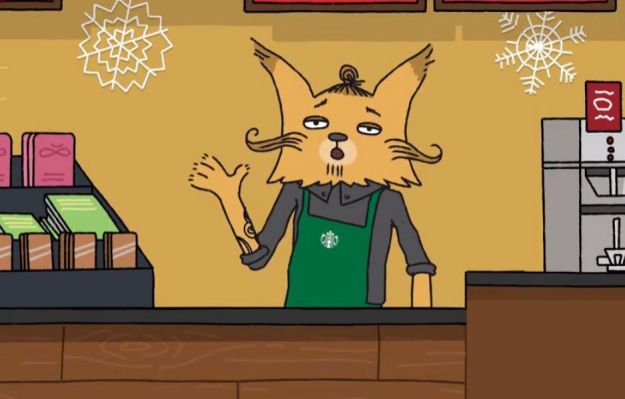Starbucks is venturing further into its own original content. On the heels of its feel-good series “Upstanders,” the coffee chain is now introducing its second video series, “1st & Main,” created by several longtime “The Simpsons” writers. “1st & Main’s” animated video shorts will kick off this Friday, and will be only around 60 to 90 seconds in length.
The idea for the new show comes from three writers of “The Simpsons,” John Frink, Joel H. Cohen and Rob LaZebnik, who’ve spent a lot of time working from Starbucks stores themselves. The videos they’ve created will focus on Starbucks’ culture – the stores, the baristas, and the customers.
“As much as we are supposed to be working, we are even better at procrastinating,” said LaZebnik, in an announcement about the new show. “Looking around, you can’t help but see the vibe in there – the partners (employees), the regular customers, the flow of morning traffic. We thought we could bring that to life in a really fun way.”
Instead of animated people, the cast of characters are animals: a bear called Julie is a store manager, a beagle named Chet is a local contractor, and Diego is a cat that works behind the counter to serve people drinks.
The series will be posted online on the Starbucks website, but the company will also market the episodes to customers via the Starbucks mobile app and social media sites like Facebook, Instagram and YouTube. It will run for eight weeks.
Unlike Upstanders, whose videos lasted several minutes and told inspirational stories of compassion, citizenship and civility, “1st & Main” is meant to be more cute and funny – and short enough that you could watch an entire video while you wait in line.
Starbucks is no stranger to aligning its brand with digital content, of course. The company has worked with Apple’s iTunes to promote music and apps, and more recently partnered with Spotify on the music it plays in stores. It has also promoted a number of movies, books and music inside its stores for years.
What’s different now is that the company wants to get in the business of making content itself, instead of only working with third parties. It also has the means to promote that content itself via its digital platforms like the Starbucks mobile app and the homepage that pops up for customers using the store’s free Wi-Fi, for example.
Prior to this video series launch, Starbucks had detailed a number of its technology-related plans at its investor conference earlier this month. But it didn’t announce any of its media and entertainment plans or forthcoming deals at that time.
However, the company’s interest in producing its own media was previously reported last year, when Rajiv Chandrasekaran, a former senior editor at “The Washington Post,” left the paper to form a new production company in Seattle, where Starbucks is headquartered.
